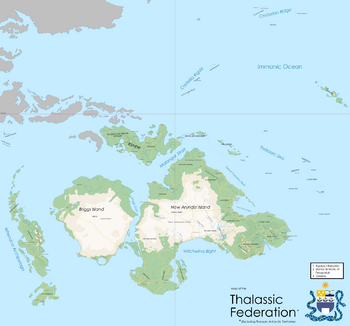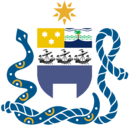Thalassic Federation
Thalassic Federation | |
|---|---|
| Motto: United we stand. | |
| Anthem: [1] "United We Stand" | |
 Map of the Thalassic Federation | |
| Capital | Nelson |
| Largest city | Strafton |
| Official languages | None Federally |
| Recognised national languages | Antipodean Estarian, Safotuan, Kangungu, Ayamaru, Hiri Taori, Kimbean Creole, Ngatuvian, Mā'ohi, Sakawiian, Vitian, Woomaruan, Antipodean Creole, Agarput, TBA. |
| Ethnic groups (2020) | White (52.4%) Aboriginal Antipodeans (7.6%) Mixed Race (19.1%) Black (6.1%) !Asian (5.0%) Thalassic Islander (4.9%) Agarput (4.3%) |
| Demonym(s) | official Thalassic unofficial Antipodean |
| Government | Federal presidential constitutional republic |
| President Samuel Taita | |
| Vice President William Digby | |
• Water (%) | 6% |
| Population | |
• 2020 census | 118,142,347 |
| GDP (PPP) | 2021 estimate |
• Total | $4,846,703,101,853 |
• Per capita | $41,024 |
| GDP (nominal) | 2021 estimate |
• Total | $3,676,057,697,310 |
• Per capita | $31,155 |
| Gini (2021) | 23.1 low |
| HDI (2021) | very high |
| Currency | Thalassic Dollar (THD) |
| Date format | dd/mm/yyyy (AD) |
| Driving side | left |
| Calling code | +493 |
| ISO 3166 code | FED |
| Internet TLD | .fed |
The Thalassic Federation is an island country in the TBA and TBA Oceans. It consists of over 11,000 islands, with the largest of these being the Antipodean Islands of New Arundel, Briggs Island and the islands of West Kimbe and Apanui Island. The Thalassic Federation is the largest country by land area in Regnum and has the largest maritime borders of any country. It is administered by the President and the Thalassic Parliament, for which an election is held every three years. The Parliament is composed of both the Senate and Federal Assembly, which are the upper and lower houses, respectively. The Thalassic Federation is composed of 30 semi-autonomous regions, with the largest of these being the Southeast Highlands region which has a population of 28,540,102 people and is home of both the capital, Nelson and largest city, Strafton. It is the largest country in Regnum by land area, and has the largest maritime boundaries in the world.
The first human settlement within the Thalassic Federation dates back over 65 thousand years ago, near Lake Witchelina in the region of the Witchelina Basin. Indigenous Antipodean people are often considered one of the oldest cultures in the world, Colonization began in 1782, the first of which was the Strafton colony. The first of these colonies to gain independence was Antipodea, which gained independence in 1856 from Estaria. The Thalassic Federation itself was founded in 1954 as a federalization of the previously existing organization, the Thalassic Union this date is celebrated across the Federation and is known as "Federation Day".
The Thalassic Constitution was ratified upon founding in 1954, and defines the Thalassic Federation as a union of 23 (at the time) federal Republics and territories. As of 2021 there are 30 federal regions and 12 territories. A large number of these regions are small island nations, and despite long term development efforts many of these remain relatively impoverished and underdeveloped, with economies primarily revolving around fishing, tourism and in some cases mining. A combination of anti-flooding and cyclone protection efforts in the Thalassic have led to a greater level of development in many of these island regions, and accompanied by sound economic management and a miraculous recovery from the Millenium Crash have in the last ten to twenty years allowed unparalleled economic growth bringing the Federation from an underdeveloped backwater to one of the leading economies in the world.
The Thalassic Federation is a bicameral representative democracy which holds elections for both houses every three years. The Federation has always ranked highly in human rights, social and wealth equality, and freedom, and has in recent years dramatically increased in its global rankings for economic development, education and healthcare.
Etymology
History
Indigenous Peoples
Before TBA colonialism the disparate lands of the Thalassic Federation were occupied by many different cultures and it is generally accepted that these migrated to the Thalassic Archipelago by means of canoe and primitive seafaring vessels via South East TBA. The first human cultures found in the Federation date back to 65 thousand years ago and were found in the Antipodean island of Briggs Island.
Exploration and Colonization
The first Thalassic territory to be colonized were the Antepodean island of New Arundel, forming the Strafton Colony in 1782. The Strafton colony grew to one of the largest !European settlements in the far east, becoming an important cargo port. Shortly afterwards, Estarian colonists annexed several Thalassic Islands including King George Island (later renamed to Safotua) and Sakawii. Most of these colonies were either slave plantation colonies (mostly growing sugar and cotton) or penal colonies, many were both.
Antipodean Independence
A miners strike in the Southeast Highlands in 1856 grew into widespread insurrection against the Estarian administration. A lengthy conflict ensued which culminated in the independence of the three major Antipodean colonies of New Arundel, Briggs and Whenua. These three colonies formed the Antipodean Republic, often considered a precursor state to the Thalassic Federation.
TBA
During the TBA War, the Antipodean Republic was a member of the TBA, and fought to liberate Estarian colonies in the Thalassic. After the war, the various Estarian island colonies formed the Thalassic Union, a union of mostly autonomous island republics under the protection of the Antipodean Republic.
Formation of the Thalassic Federation
The Antipodean Republic became a signatory to the Thalassic Union in 1948. Five years later, member states of the Union voted to expand the jurisdiction of the Union to oversee foreign policy decisions and national military requirements. To maintain a level of population balance between regions of the newly formed Thalassic Federation, the colonies of Whendua and New Arundel were disassembled into 4 and 16 constituent member states respectively, which would directly organize with the Federal government and operate as mostly autonomous regions.
Agarput Crisis
The Agarput Republic is the most recent addition to the Federation, following a referendum in 1984 to join as a special administrative republic. Protests quickly erupted from local nationalist groups which clashed with local police and Federal agents. These protests died down by 1985 and were replaced by an underground discontentment. Rapid economic growth of the mid 1980s led to alot of popular support for the new administration, and multiple expensive infrastructure projects aimed at raising the standard of living and local economy saw much success. However in fiscal year 1987 the Thalassic Economy partially collapsed, with the FedSX hitting record lows, and threatening to undo the unchecked stellar growth of the past half decade. Austerity measures saw many of these Agarput infrastructure projects cancelled, and an increase in taxation across the Federation. Protests against these measures turned violent when Thalassic Federal police violently suppressed protestors using tear gas and batons.
Tensions looked to boil to a head with the bombing of the local senate house, perpetrated by local Hindu extremist groups. Several prominent nationalist and Hindu extremist leaders were arrested after the attacks, leading to a series of armed uprisings in the region. Several clashes turned violent, and by mid 1987 the death toll in total was over 150 killed in sporadic gunfights and terror attacks. This period also saw several terror attacks committed elsewhere in the Federation, including one bombing in Nelson and a hostage situation leading to the deaths of 27 Antipodeans in Strafton.
The Federation Armed Forces were deployed to the Agarput Republic in force in June of 1987, with an initial deployment of 30,000 men which increased to 60,000 by years end. Although the violence mostly dissipated by November, economic damage from the brief conflict and economic collapse bled on into the following years, tanking Thalassic economic growth and causing mass inflation of as much as 3,000% in 1989, with the economy returning to normal by 1994.
The Agarput crisis led to a series of broad policy changes in the Federation, including the creation of a dedicated military force to solve domestic issues without resorting to traditional military forces. The Federation also implemented a new policy to refuse to accept new members without at least a ten year transitory period and sweeping economic reforms including the nationalization of several key industries including Uranium, Coal and Oil extraction, as well as checks on lending and regulations placed upon the stock exchange.
Kimbe War
Politics
Government
Foreign relations
Military
Administrative divisions
Geography
Location
Flora and fauna
Science
Economy
The Thalassic Federation is the Xth largest economy in Regnum, and has had the greatest sustained rate of growth since 2000. A relatively wealthy country, the Federation has a low rate of poverty and low wealth inequality. The Thalassic Federation has a mixed market economy with abundant natural resources such as coal, oil, iron ore, bauxite, uranium and natural gas. While since 1980, Thalassic growth has been unstable, since the Millenium Crash in 2000 the Thalassic Federation has due to economic reforms and growth of the local manufacturing sector enjoyed a sustained period of exceptional growth which despite slowing after 2019 has continued.
The Thalassic Dollar is the national currency. Gross domestic product per capita (PPP) was TBA as of 2021.
Energy
In 2020 the Thalassic Federation's energy sector was made up of 53% nuclear energy, 21% coal and natural gas, 18% wind and solar power and 8% hydroelectric power. The Thalassic Federation has pledge to decommission all its remaining coal and gas fired power plants by 2030, with investments worth $15 billion into renewable energy and the commissioning of a new nuclear reactor worth $18 billion to open in 2028.
Due to being home to many low-lying islands, and millions of Thalassic citizens living in critical regions vulnerable to rising sea levels, the Thalassic Federation has been a global advocate for the reduction of fossil fuel usage and greenhouse pollutants. Despite being home to the largest natural reserves of coal in Regnum, the Thalassic Federation has been steadily decreasing its exports of coal abroad. The Thalassic Federation also has the worlds largest reserves of uranium, and almost a third of global uranium reserves, most of it within the Great Antipodean Desert. Uranium, coal and energy exports to countries constitute a significant portion of the Thalassic export economy (13.1%) with the largest of these being Uranium at 7.8%, with most of that Uranium going to the Federal Union of Arcadia.
Demographics
Ethnic groups
Religion
Health
Major cities
Largest cities or towns in Thalassic Federation
2015 census | |||||||||
|---|---|---|---|---|---|---|---|---|---|
| Rank | Division | Pop. | |||||||
 Strafton  Te Tihi-o-Maru |
1 | Strafton | Southeast Highlands | 8,301,510 |  Yenda  Yarrabri | ||||
| 2 | Te Tihi-o-Maru | Motu-Apanui | 8,109,610 | ||||||
| 3 | Yenda | Yenda Basin | 4,989,112 | ||||||
| 4 | Yarrabri | Kondallila | 2,319,682 | ||||||
| 5 | Ranfurley | North Whendua Island | 1,619,682 | ||||||
| 6 | Nelson | Federal District | 1,475,016 | ||||||
| 7 | Ruaketoi | Motu Apanui | 1,404,503 | ||||||
| 8 | Media | Briggs | 1,353,114 | ||||||
| 9 | Coomba | Witchelina Basin | 1,349,760 | ||||||
| 10 | Jehembang | Agarput Republic | 811,405 | ||||||


